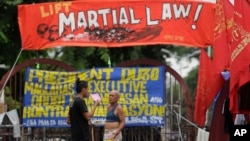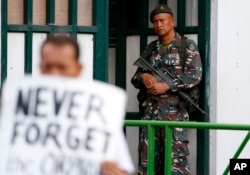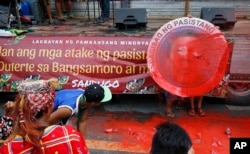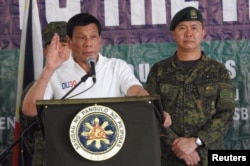Martial law declared in the southern Philippines over much of the year has had little impact on most people in the area, reducing any anxiety about a proposal to renew it in 2018.
Despite fears that martial law declared over the island of Mindanao in May would follow the harsher measures taken by authoritarian ex-president Ferdinand Marcos in 1972, people on the island say little has changed outside a single city where troops were fighting a group of armed Muslim rebels.
Philippine President Rodrigo Duterte ordered martial law through December 31 so troops and police could bypass legal procedures in capturing suspected supporters of the Islamic State-inspired Maute Group in Marawi city. The fighting ended in October with 1,127 dead, but the president is seeking an extension in 2018 as violence flares up on another part of the ever-restive island.
Extension of the law that gives local authorities the ability to declare curfews, skirt due process and set up road checkpoints is unlikely to stir fear in people outside conflict zones, locals and analysts say. So far, a lot of common Mindanao inhabitants see just the occasional checkpoint.
“It’s a different martial law compared to the martial law that was imposed in 1972,” said Oscar Moreno, mayor of Mindanao’s industrial port city Cagayan de Oro.
“There are safeguards in the Constitution that have certainly been introduced because of the lessons of the 1972 martial law, so martial law as it is universally understood may not necessarily apply here in the city or here in the province or here in Mindanao or here in the whole country.”
Fear of a Marcos era repeat
Martial law under Marcos called for curfews, bans on public assembly and military arrests of people such as Communist insurgents who were suspected of plotting to undermine the government. Marcos was afraid then the government could be toppled.
Since 1987, the Philippine constitution has set limits on martial law, including sign-off by legislators and in some cases the Supreme Court. Martial law cannot suspend the constitution.
In Mindanao this year, the Armed Forces of the Philippines had set up about 17,500 road checkpoints on the island, established curfews in 129 population centers and deployed some 9,700 people to patrol public spaces by June according to the news website Davaotoday.com.
Day in the life of a Mindanao city
But on a recent night in Moreno’s city of 675,000 people, people were shopping around dusk at a sprawling two-story mall. A group laughed and shared mobile phone content over pizza just outside, and across the street a hotel lobby bar filled with business people. No one mentioned curfews.
The only persistent sign of martial law in Cagayan de Oro, as locals told it, is a military-run checkpoint between the city and its airport about one hour’s drive to the west. Marawi lies about another hour west of the airport.
Citizens believe martial law has helped troops get a grip on Marawi and stop the war from spreading. Some expect the checkpoints to lower the risk of car-jackings on rural highways.
“For us it’s really just the checkpoints, but you get to the checks and they’re really not that strict about it anymore,” said Rhona Canoy, president of International School Cagayan de Oro. “That’s all there is, no curfews, no nothing, and that’s what it’s been like since they declared (martial law).”
Cagayan de Oro doesn’t need martial law because people in the city already “protect themselves,” said Michael Esclamado, who works as a driver in the city.
“Children seem scared about martial law, about war, that’s why I don’t like martial law here,” he said. The city has always been “100 percent safe,” he said.
Martial law renewal in 2018?
This month, the presidential office said the country’s defense department and national police have suggested to the president an extension of martial law in Mindanao, adding that Duterte is “studying the recommendations.”
“(Duterte’s) paramount concern is the security of our people especially the Mindanaoans in the face of threats and the use of available means under the law to fight them,” said a statement on the presidential website.
Officials must prove evidence of rebellion to justify martial law, but may have found one December 3. That day, the Muslim rebel group Bangsamoro Islamic Freedom Fighters killed two civilians in attacks in Maguindanao province. Duterte suspects Islamic State may be supporting those fighters to establish a caliphate, the news website Rappler.com reported.
It’s “well known they’re gathering forces,” said Eduardo Araral, associate professor at the National University of Singapore’s public policy school.
“They don’t need a lot of fighters to create a lot of havoc,” said Araral, a native of Mindanao. “They just have to hold hostage one big mall for a few days and then that could do a lot of damage psychologically to the country, so I think the military and Duterte know something that the rest of the world, the rest of the Philippines doesn’t know.”










